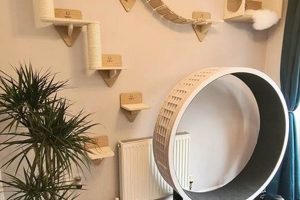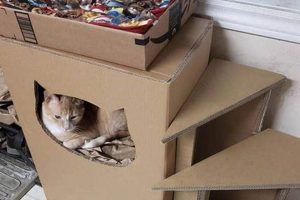A self-constructed feline shelter offers a customizable and often cost-effective alternative to commercially produced cat houses. These dwellings, typically assembled from readily available materials, provide a safe and comfortable space for domestic cats, particularly those that spend time outdoors. An example includes a structure built from repurposed shipping pallets, modified with insulation and weatherproofing for enhanced protection.
The advantages of creating a personalized cat shelter are multifaceted. Such projects promote resourcefulness and reduce waste through material repurposing. Furthermore, these creations can be tailored to meet specific spatial requirements and aesthetic preferences, seamlessly integrating with existing outdoor environments. Historically, homemade animal shelters have served as essential resources for pet owners seeking affordable and adaptable housing solutions.
The subsequent sections will delve into the construction process, material selection, design considerations, and strategies for ensuring feline comfort and safety within the context of building a customized outdoor cat habitat.
DIY Cat House Construction Tips
Effective planning and execution are crucial for constructing a durable and comfortable outdoor shelter for felines. The following tips offer guidance on various aspects of the building process.
Tip 1: Prioritize Weather Resistance: Employ materials resistant to moisture and temperature fluctuations. Pressure-treated lumber or sealed plywood are recommended for structural elements. Consider a sloped roof design to facilitate water runoff, preventing water damage.
Tip 2: Ensure Adequate Insulation: Insulation is essential for maintaining a stable temperature within the structure. Rigid foam insulation board, properly sealed within the walls and roof, helps regulate internal temperature, providing warmth in winter and coolness in summer.
Tip 3: Incorporate Multiple Escape Routes: Felines require multiple exits for safety and a sense of security. Design two or more entrances/exits to allow for escape from potential predators or confinement. Ensure openings are appropriately sized for cat passage.
Tip 4: Select Non-Toxic Materials: Choose construction materials, finishes, and adhesives that are non-toxic to animals. Avoid treated lumber containing arsenic or chromium. Opt for water-based, low-VOC paints or sealants specifically designed for pet environments.
Tip 5: Elevate the Structure: Raising the construction off the ground minimizes moisture exposure and improves ventilation. Use concrete blocks or pressure-treated skids to elevate the base, preventing rot and insect infestation.
Tip 6: Provide a Covered Entrance: An overhang or covered porch area provides protection from rain and snow before entering the shelter. This feature helps keep the interior drier and reduces drafts.
Tip 7: Consider Interior Comfort: Furnish the interior with soft bedding, such as blankets or straw, to provide warmth and comfort. Avoid using cedar shavings or heavily scented materials, as they may be irritating to feline respiratory systems.
By adhering to these recommendations, the resulting structure will offer a safe, comfortable, and weather-resistant haven for its feline inhabitants.
The subsequent sections will cover design considerations and long-term maintenance strategies, ensuring the continued effectiveness of the customized shelter.
1. Weatherproof Materials
The durability and utility of any self-constructed feline shelter are directly correlated to the selection of weatherproof materials. A shelter exposed to environmental elements without adequate protection degrades rapidly, negating its purpose of providing refuge. Material selection, therefore, constitutes a primary consideration in “diy cat house” construction, determining its longevity and the occupant’s well-being. For instance, untreated wood exposed to rain will rot, compromising structural integrity and creating unsanitary conditions. Similarly, non-waterproof insulation loses its thermal properties when wet, rendering it ineffective in regulating temperature. Choosing appropriately resistant materials mitigates these risks.
Practical application involves selecting materials specifically designed to withstand exposure to moisture, wind, and temperature fluctuations. Pressure-treated lumber, recycled plastics, and metal roofing are frequently employed to create weatherproof structures. These materials offer resistance to rot, insect infestation, and water damage, extending the lifespan of the shelter. Sealing all joints and seams with waterproof caulk further enhances protection against water penetration. Implementation of a sloping roof ensures efficient water runoff, preventing pooling and minimizing the risk of leaks. Furthermore, incorporating ventilation helps to reduce moisture buildup within the shelter, maintaining a dry and comfortable environment for the cat.
Effective utilization of weatherproof materials is essential for the successful construction of a durable and protective feline shelter. The challenge lies in balancing cost-effectiveness with material performance, selecting options that provide adequate protection without exceeding budgetary constraints. By prioritizing weather resistance in material selection and employing appropriate construction techniques, a functional and long-lasting shelter can be created, ensuring feline safety and comfort.
2. Structural Stability
Structural stability, within the context of a self-constructed feline shelter, directly determines its ability to withstand external forces and maintain its form over time. A lack of structural integrity can lead to collapse, compromising the safety of the animal and rendering the shelter useless. The connection between “structural stability” and “diy cat house” is, therefore, a causal one: insufficient stability results in functional failure. For example, a structure built with inadequately joined materials may succumb to wind pressure or snow load, creating a hazardous situation for its occupant. The importance of stability as a foundational element cannot be overstated.
Achieving adequate structural stability involves several practical considerations. Proper selection of building materials is crucial; pressure-treated lumber or durable composites are often preferred for their strength and resistance to decay. Secure joinery methods, such as screws and bolts in conjunction with appropriate adhesives, ensure that the components of the structure are firmly connected. Reinforcement of critical stress points, like corners and roof supports, provides added protection against deformation or failure. A well-designed foundation, whether a solid base or elevated platform, distributes the load evenly and prevents settling. Furthermore, consideration of local climate conditions wind speeds, average snowfall, and seismic activity informs the necessary level of structural reinforcement.
In conclusion, the structural stability of a self-built cat house is not merely a desirable attribute but a fundamental requirement for ensuring its functionality and safety. While design aesthetics and material cost are important considerations, they should not supersede the need for a structurally sound and durable shelter. The challenge lies in balancing these factors to create a cost-effective and aesthetically pleasing structure that provides long-term protection and comfort for its feline occupant. Understanding the principles of structural engineering and applying them to the building process greatly enhances the probability of success.
3. Internal Comfort
Internal comfort is a primary determinant of a self-constructed feline shelter’s utility. Without an environment conducive to feline well-being, the structure remains unused, negating its purpose. The connection between a “diy cat house” and internal comfort is, therefore, one of functional necessity: the shelter must offer more than mere protection; it must actively promote feline habitation.
- Thermal Regulation
Maintaining a stable internal temperature is paramount for feline comfort. Insulation materials, strategically incorporated into the walls and roof, mitigate temperature extremes. In cold climates, insulation retains warmth, preventing hypothermia. Conversely, in hot climates, it reduces heat absorption, minimizing the risk of overheating. The choice of insulation, therefore, directly impacts the cat’s ability to maintain a comfortable core temperature, influencing its likelihood of occupying the shelter.
- Dryness and Ventilation
Excessive moisture creates an environment conducive to mold growth and bacterial proliferation, both of which pose health risks to felines. Adequate ventilation is essential for removing moisture and maintaining air quality. Properly positioned vents, combined with a water-resistant roof and elevated floor, prevent water accumulation and promote air circulation. This combination creates a dry, well-ventilated space that minimizes the risk of respiratory infections and skin irritations.
- Soft Bedding and Substrate
The provision of comfortable bedding materials significantly enhances feline occupancy rates. Soft blankets, cushions, or straw provide a comfortable surface for resting and sleeping. The selection of appropriate substrate is also critical; cedar shavings, for instance, contain volatile oils that can irritate feline respiratory systems. Opting for hypoallergenic alternatives, such as shredded paper or fleece, reduces the risk of allergic reactions and enhances the overall comfort level.
- Security and Enclosure
Felines possess an innate preference for enclosed spaces, which provide a sense of security and protection from perceived threats. The internal dimensions of the shelter should be sufficient to allow for comfortable movement and stretching, but not so large as to create a feeling of vulnerability. A smaller, enclosed space fosters a sense of safety, encouraging the cat to utilize the shelter as a secure retreat.
The combined effect of these factors determines the level of internal comfort achieved within a self-built feline shelter. Prioritizing thermal regulation, dryness, comfortable bedding, and a sense of security is crucial for creating a space that is not only functional but also appealing to its intended occupant. By carefully considering these aspects, a “diy cat house” can be transformed from a mere structure into a welcomed haven for feline inhabitants.
4. Safety Features
Safety features are paramount in the design and construction of any self-built feline shelter. Their implementation directly mitigates potential hazards and ensures the well-being of the animal utilizing the structure. A “diy cat house” lacking adequate safety considerations can inadvertently create an unsafe environment, undermining its intended purpose of providing refuge.
- Predator Evasion Measures
Multiple escape routes are crucial for allowing a cat to quickly evade potential predators. This typically involves designing at least two separate entrances/exits. The size of these openings must be adequate for feline passage while being small enough to deter larger animals. Placement should be considered to allow for unobstructed escape pathways. Example: A raised platform with entry points on opposite sides prevents cornering. Implications involve reduced stress and increased survival rates for outdoor cats.
- Non-Toxic Material Selection
The choice of building materials is critical for preventing poisoning or allergic reactions. Pressure-treated lumber containing arsenic or creosote poses significant health risks. Similarly, certain paints, sealants, and adhesives release harmful volatile organic compounds (VOCs). Safe materials include untreated wood, water-based paints specifically labeled as pet-safe, and formaldehyde-free adhesives. Example: Using cedar shavings as bedding can cause respiratory irritation. Implications involve the avoidance of long-term health problems and immediate toxic reactions.
- Stable Construction and Structural Integrity
A structurally unsound shelter poses a direct threat to the cat occupying it. Weak joints, inadequate support, or unstable foundations can lead to collapse, resulting in injury or death. Proper construction techniques, including secure fastening methods and reinforcement of critical stress points, are essential. Example: A poorly attached roof can detach during high winds. Implications involve the prevention of physical trauma and the provision of a reliable shelter.
- Protection from Environmental Hazards
The shelter must offer protection from extreme weather conditions, including rain, snow, wind, and extreme temperatures. Overhangs or covered entrances prevent rain from entering the shelter. Adequate insulation maintains a stable internal temperature. Proper sealing prevents drafts and minimizes heat loss. Example: An uninsulated shelter can lead to hypothermia in winter. Implications involve enhanced resilience to environmental stressors and increased survival rates during inclement weather.
In conclusion, safety features represent a non-negotiable aspect of any self-constructed feline shelter. The implementation of predator evasion measures, non-toxic materials, stable construction, and protection from environmental hazards directly contributes to the well-being and survival of the cat. By prioritizing these considerations, a “diy cat house” can effectively serve its intended purpose of providing a safe and comfortable refuge.
5. Cost Effectiveness
Cost effectiveness, in the context of self-constructed feline shelters, is a crucial determinant of accessibility and practicality. The connection between a “diy cat house” and cost effectiveness resides in the ability to provide adequate shelter at a significantly reduced expense compared to commercially available options. A direct causal relationship exists: higher material costs directly reduce the accessibility of a homemade shelter, potentially negating its viability as a solution for individuals with limited financial resources. The economic benefits of this approach lie in material repurposing, reduced labor expenses, and avoidance of retail markups. For example, using reclaimed wood pallets instead of purchasing new lumber drastically lowers project costs. This allows individuals to allocate resources to other essential pet care needs.
Practical application of cost-effective strategies involves careful material sourcing, efficient design, and judicious labor allocation. Repurposed materials, such as discarded lumber, plastic containers, or fabric remnants, offer substantial cost savings. A simplified design minimizes material requirements and construction time, reducing overall expenses. Utilizing readily available tools and avoiding specialized equipment further enhances cost efficiency. For example, a shelter constructed from a repurposed plastic storage container, insulated with recycled fabric scraps, and requiring only basic cutting and assembly, represents a cost-effective solution. Long-term cost benefits also accrue through durability, reducing the need for frequent replacements or repairs.
In summary, cost effectiveness is not merely a desirable attribute of a self-built feline shelter; it is a key factor influencing its feasibility and accessibility. The challenge lies in balancing cost considerations with structural integrity, safety, and comfort. While utilizing repurposed materials and simplified designs can significantly reduce expenses, it is essential to ensure that these measures do not compromise the quality or longevity of the shelter. Ultimately, a successful “diy cat house” embodies a balance between affordability and functionality, providing a safe and comfortable refuge for felines without imposing undue financial burden.
Frequently Asked Questions Regarding DIY Cat Houses
The following addresses common inquiries concerning the construction and maintenance of self-built feline shelters. These responses aim to provide clarity and guidance for individuals undertaking such projects.
Question 1: What are the essential dimensions for a functional feline shelter?
While dimensions vary based on feline size, a minimum internal space of 24 inches by 18 inches is recommended to allow for comfortable movement and rest. Height should be sufficient to allow the cat to sit upright without obstruction, typically around 12-18 inches.
Question 2: How frequently should a DIY cat house be cleaned?
The frequency of cleaning depends on usage and environmental conditions. Regular removal of debris, such as leaves or dirt, is recommended. Bedding should be laundered or replaced at least monthly, or more frequently if visibly soiled. A thorough cleaning with a pet-safe disinfectant should occur at least twice annually.
Question 3: Is it necessary to insulate a DIY cat house, even in mild climates?
While not always essential in consistently mild climates, insulation offers benefits in mitigating temperature fluctuations. Even in areas with moderate winters, insulation can prevent the shelter from becoming excessively cold during brief periods of sub-freezing temperatures. Insulation also provides a buffer against extreme heat during summer months.
Question 4: What are the best options for securing a DIY cat house against strong winds?
Several methods exist for securing a feline shelter against wind. The structure can be anchored to the ground using stakes or ground screws. Adding weight to the base, such as sandbags or concrete blocks, provides additional stability. Positioning the shelter in a sheltered location, protected by fences or buildings, also reduces wind exposure.
Question 5: Can repurposed materials be safely used in constructing a DIY cat house?
Repurposed materials are often suitable for feline shelter construction, provided they are clean, non-toxic, and structurally sound. Avoid using treated lumber containing arsenic or creosote. Ensure that any paints, sealants, or adhesives are pet-safe and low in VOCs. Discarded materials should be thoroughly inspected for sharp edges or protruding nails before use.
Question 6: How can multiple cats be accommodated within a single DIY cat house?
Accommodating multiple cats requires increasing the internal dimensions of the shelter proportionally. Multiple entrances/exits are crucial to prevent territorial disputes or confinement. Providing separate bedding areas or elevated platforms allows cats to establish individual spaces within the shared structure.
Proper construction and maintenance are essential for ensuring that a self-built feline shelter provides a safe and comfortable environment for its occupants. Adherence to the guidelines outlined above enhances the utility and longevity of the structure.
The following sections will explore advanced design considerations for optimizing feline shelter performance.
Conclusion
This exploration of “diy cat house” construction has illuminated essential considerations for creating functional and safe shelters. The importance of material selection, structural integrity, internal comfort, safety features, and cost-effectiveness has been emphasized. Prioritizing these elements is crucial for ensuring the shelter’s utility and longevity.
Effective application of these principles empowers individuals to provide customized, affordable housing solutions for felines. Continued attention to design innovation and material advancements will further enhance the performance and accessibility of self-built cat shelters, promoting animal welfare within diverse communities.







